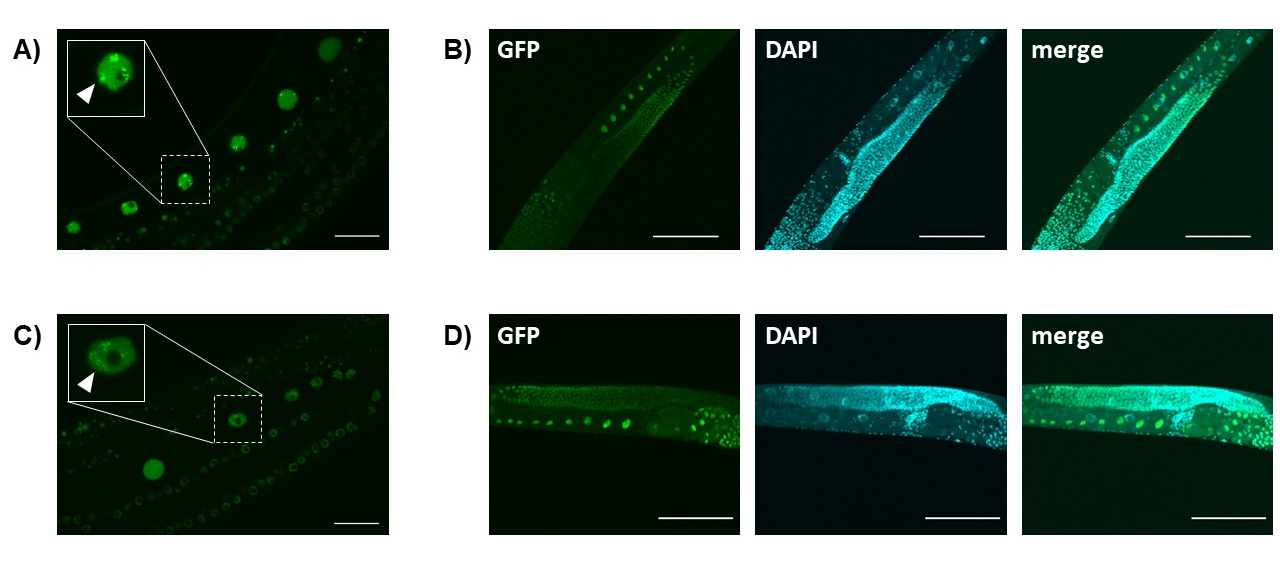Department of Biochemistry and Molecular Biology, Faculty of Agriculture and Life Science, Hirosaki University, 3 Bunkyo-cho, Hirosaki, 036-8561
Description
T26A8.4 encodes a CCCH-type zinc finger protein. The amino acid sequence of this protein is partially similar to that of S. cerevisiae Caf120p, which has no zinc finger domain. T26A8.4-encoded RNA was detected more abundantly in germ cells than in other tissues of L4-adult worms according to the NEXTDB data. When expressed specifically in the germline under control of the mex-5 promoter, the T26A8.4-encoded protein localized to germ cell nuclei in the adult hermaphrodite and can be seen in foci (arrowheads in the insets of panels A and C). During germline development, gene expression is primarily regulated posttranscriptionally by the mRNA stability and/or translation with the 3’UTRs (Merritt et al. 2008). To test the post-transcriptional regulation of T26A8.4 expression, T26A8.4::GFP with its own 3’UTR and that with tbb-2 3’UTR were compared. The results showed that T26A8.4 is expressed throughout the germline with both 3’UTRs, indicating that T26A8.4 does not appear to be post-transcriptionally regulated by its 3’UTR.
pTKD841 was made by cloning a fusion of PCR fragments of genomic mex-5 promoter with mex-55’UTR (523 bp), genomic T26A8.4 (2068 bp), a linker amino acid (Gly-Gly-Gly-Gly-Gly-Ala) coding sequence (18 bp), gfp (870 bp) and genomic T26A8.4 3’UTR (459 bp) with its downstream sequence (144 bp) into the Sbf1 site of a plasmid vector pCFJ151 (Zeiser et al. 2011). pTKD842 was made as pTKD841 except for the 3’UTR. Genomic tbb-2 3’UTR (297 bp) with its downstream sequence (32 bp) was fused to gfp in pTKD842. These plasmids were introduced into C. elegans EG4322 with plasmids pRF4 and pCFJ601 to make strains HUJ0001 and HUJ0002, respectively, by a MosSCI method (Frøkjær-Jensen et al. 2008; Frøkjær-Jensen et al. 2012). GFP signal was detected in the germ cell nuclei in both strains. Panels A) and C) show GFP signal from live imaging of HUJ0001 and HUJ0002, respectively. The inset of each panel shows the magnified image of an oocyte (dashed square) in an adult hermaphrodite. The foci were observed in the nucleus of diplotene stage to that of -1 oocyte. Some pachytene stage nuclei also exhibited the foci. Scale bars, 20 mm. Panels B) and D) show GFP signal with DAPI staining image of the fixed specimens of HUJ0001 and HUJ0002, respectively. The foci observed from the live imaging could not be detected. GFP, T26A8.4::GFP; DAPI, DAPI staining image; merged, merged image of GFP and DAPI. Scale bars, 100 um.
Reagents
Plasmids:
pCFJ151 (ttTi5605_MCS)
pCFJ601 (Peft-3::Mos1 transposase::tbb-2 3’UTR)
pRF4 (rol-6 (su1006))
pTKD841 (Pmex-5::mex-5 5’ UTR::T26A8.4::GFP::T26A8.4 3’ UTR)
pTKD842 (Pmex-5::mex-5 5’ UTR::T26A8.4::GFP::tbb-2 3’ UTR)
C. elegans strains:
EG4322 (ttTi5605mos II; unc-119 (ed3) III)
HUJ0001 (huaIs001[pTKD841(Pmex-5::mex-5 5’ UTR::T26A8.4::GFP::T26A8.4 3’ UTR Cbr-unc-119 (+))] II; unc-119 (ed3) III)
HUJ0002 (huaIs002[pTKD842(Pmex-5::mex-5 5’ UTR::T26A8.4::GFP::tbb-2 3’ UTR Cbr-unc-119 (+))] II; unc-119 (ed3) III).
References
Curated Data
| Plasmid | pCFJ151 (ttTi5605_MCS) | |
| Plasmid | pCFJ601 (Peft-3::Mos1 transposase::tbb-2 3’UTR) | |
| Plasmid | pRF4 (rol-6 (su1006)) | |
| Plasmid | pTKD841 (Pmex-5::mex-5 5’ UTR::T26A8.4::GFP::T26A8.4 3’ UTR) | |
| Plasmid | pTKD842 (Pmex-5::mex-5 5’ UTR::T26A8.4::GFP::tbb-2 3’ UTR) | |
| C. elegans strain | EG4322 (ttTi5605mos II; unc-119 (ed3) III) | |
| C. elegans strain | HUJ0001 (huaIs001[pTKD841(Pmex-5::mex-5 5’ UTR::T26A8.4::GFP::T26A8.4 3’ UTR Cbr-unc-119 (+))] II; unc-119 (ed3) III) | |
| C. elegans strain | HUJ0002 (huaIs002[pTKD842(Pmex-5::mex-5 5’ UTR::T26A8.4::GFP::tbb-2 3’ UTR Cbr-unc-119 (+))] II; unc-119 (ed3) III). |
Funding
JSPS KAKENHI Grant Number JP25440002
Reviewed By
AnonymousHistory
Received: September 11, 2018Accepted: September 29, 2018
Published: September 29, 2018
Copyright
© 2018 by the authors. This is an open-access article distributed under the terms of the Creative Commons Attribution 4.0 International (CC BY 4.0) License, which permits unrestricted use, distribution, and reproduction in any medium, provided the original author and source are credited.Citation
Koyama, T; Ushida, C (2018). Nuclear localization of a C. elegans CCCH-type zinc finger protein encoded by T26A8.4. microPublication Biology. 10.17912/YHG7-JE66.Download: RIS BibTeX




